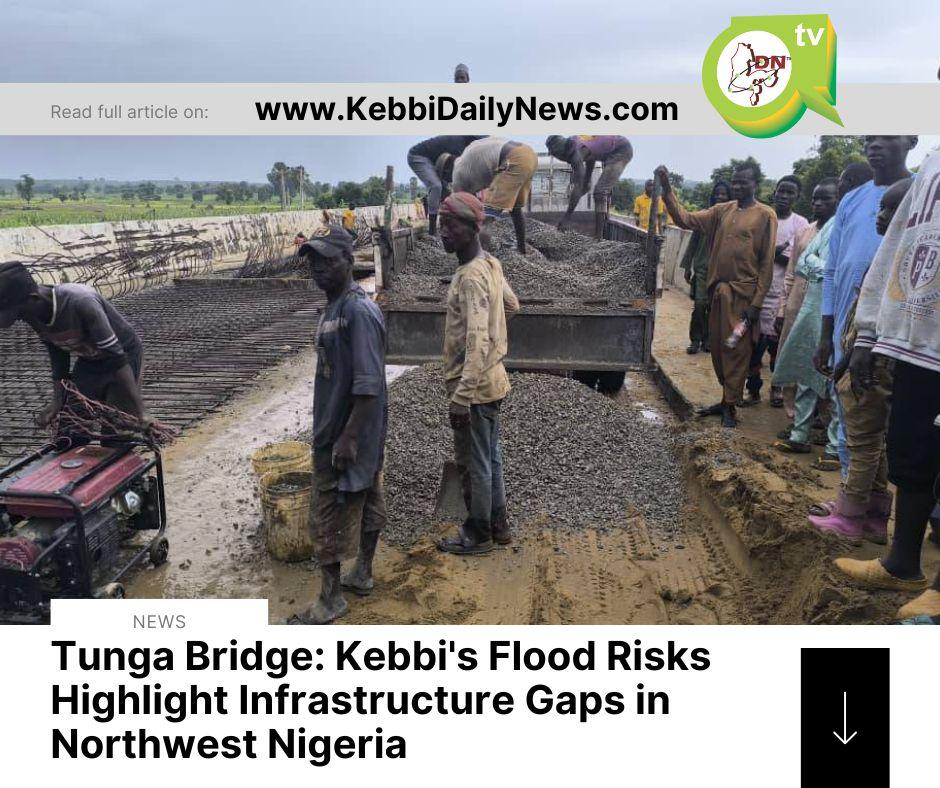
Tunga Bridge: Kebbi's Flood Risks Highlight Infrastructure Gaps in Northwest Nigeria
By Kebbi Daily News on October 17, 2025
In 2025, Kebbi State has faced similar challenges. Flash floods on August 15-16 affected Dandi and Suru LGAs, destroying bridges at Fana and Dakingari-Kyangakwai.
Bagudo, Kebbi State – October 17, 2025 – The Tunga Bridge over the Niger River in Bagudo Local Government Area serves as a key connection between Kebbi State and Benin. Reconstructed in 2021 following a major flood in 2020, the bridge supports trade and daily movement for local residents. However, recent flooding in August 2025 has raised concerns about its long-term durability. Nearby bridges collapsed during those floods, disrupting transport and economies in the area. Officials and residents are calling for stronger measures to address recurring flood threats in the region.
The original Tunga Bridge was destroyed in September 2020 when heavy rains caused the Niger River to overflow. The collapse isolated Bagudo LGA, affecting over 200,000 people and halting cross-border trade with Benin and Niger. Three people died attempting to cross the river during the incident. The Federal Road Maintenance Agency (FERMA) responded by allocating funds in December 2020. Construction began soon after, and the bridge reopened in April 2021. The new design includes three reinforced culverts and 300 meters of concrete retaining walls to handle higher water flows. Local leaders, including Governor Atiku Bagudu and Bagudo chairman Muhammad Kaura, oversaw the project. Residents welcomed the reopening, noting its importance for economic recovery.
In 2025, Kebbi State has faced similar challenges. Flash floods on August 15-16 affected Dandi and Suru LGAs, destroying bridges at Fana and Dakingari-Kyangakwai. One person died, and three trucks from Benin, Côte d'Ivoire, and Togo fell into the water at Fana, causing losses estimated at ₦100 million in cargo. Other bridges, including Makera-Kangiwa and Zogirma-Tili, were also damaged, cutting off access to rice-producing areas. The August 18 floods in Birnin Kebbi impacted nine communities, while later events in October added to the toll across Taraba and other states. A 2024 National Emergency Management Agency (NEMA) report indicates that 70% of Kebbi's more than 100 bridges are at risk from floods, with projections of 20-30% more rainfall by 2030 due to climate changes.
Several factors contribute to these issues. Kebbi's location in the Sokoto-Rima river basin makes it prone to overflows from upstream dams in Mali and Niger. Deforestation has reduced tree cover by 15% since 2015, increasing runoff during rains. Many bridges, including the pre-2021 Tunga, date back to the 1970s and were not built for current traffic or weather patterns. FERMA's upgrades at Tunga improved water capacity by 50%, but only 40% of federal roads in Kebbi have similar protections. The 2025 national budget for FERMA stands at ₦50 billion, which experts say is insufficient. A July 2025 Independent Corrupt Practices Commission (ICPC) investigation revealed ₦2 billion diverted from northwest road projects, further delaying maintenance.
The impacts are significant for local communities. The 2020 Tunga collapse led to ₦500 million in trade losses, according to the local chamber of commerce, affecting markets in Gaya, Benin. Farmers in Dandi lost 2,000 hectares of rice, potentially reducing Kebbi's annual output of 1.5 million tons by 10%. Women, who handle much of the informal cross-border trade, face longer travel times and higher risks on bandit-affected roads. A local vendor, Aisha Bello from Fana, reported her family now eats only one meal a day due to disrupted supplies. Kebbi's border areas contribute ₦200 billion annually to ECOWAS trade, and flood disruptions have driven up prices for staples like garri by 25%. Social media discussions under #KebbiFloods have criticized the federal government's handling of infrastructure.
Governor Nasir Idris responded to the August floods by sending Deputy Senator Umar Abubakar to Fana with ₦50 million in aid and food supplies. A damage assessment team visited areas from Bunza to Zuru. The governor requested additional federal support, similar to efforts after 2020. Local philanthropist Alhaji Hassan Adamu funded a temporary bypass for the Mayalo Bridge. FERMA has pledged more retrofits like those at Tunga. Kebbi Works Commissioner Yakubu Ahmed stated that without reliable bridges, food shortages could worsen. NEMA issued early warnings for relocations, but only 30% of residents complied.
To address these problems, several steps are recommended. First, adopt designs like Tunga's, raising bridge decks by 2 meters and adding flood sensors, as tested in Lagos. Second, increase FERMA's budget to ₦100 billion for northwest priorities, with regular anti-corruption checks. Third, launch reforestation in Kebbi, targeting 10,000 hectares with a ₦1 billion program. Fourth, strengthen regional agreements with Niger and Benin for better dam management. Finally, train local cooperatives in Bagudo, reaching 5,000 people in flood-resistant farming and using mobile alert systems.
The Tunga Bridge's survival in 2025 shows progress, but broader vulnerabilities remain. Village head Muhammad Tuga emphasized the need for ongoing maintenance. Without comprehensive action, floods will continue to threaten Kebbi's role as a food supplier. Federal and state governments must prioritize these investments to prevent future disruptions.